14.6E: Exercises for Section 14.6
- Last updated
- Jun 1, 2021
- Save as PDF
- Page ID
- 66954
( \newcommand{\kernel}{\mathrm{null}\,}\)
In exercises 1 - 12, the region R occupied by a lamina is shown in a graph. Find the mass of R with the density function ρ.
1. R is the triangular region with vertices (0,0), (0,3), and (6,0); ρ(x,y)=xy.
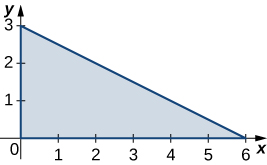
- Answer
- 272
2. R is the triangular region with vertices (0,0), (1,1), and (0,5); ρ(x,y)=x+y.
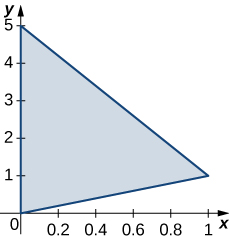
3. R is the rectangular region with vertices (0,0), (0,3), (6,3) and (6,0); ρ(x,y)=√xy.
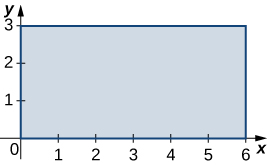
- Answer
- 24√2
4. R is the rectangular region with vertices (0,1), (0,3), (3,3) and (3,1); ρ(x,y)=x2y.
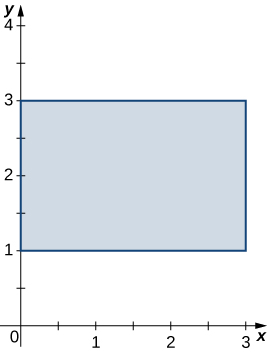
5. R is the trapezoidal region determined by the lines y=−14x+52, y=0, y=2, and x=0; ρ(x,y)=3xy.
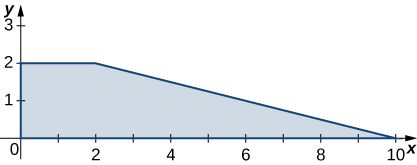
- Answer
- 76
6. R is the trapezoidal region determined by the lines y=0, y=1, y=x and y=−x+3; ρ(x,y)=2x+y.
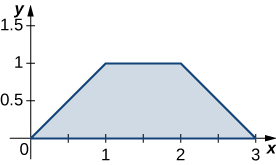
7. R is the disk of radius 2 centered at (1,2); ρ(x,y)=x2+y2−2x−4y+5.
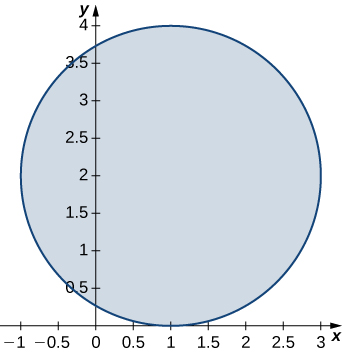
- Answer
- 8π
8. R is the unit disk; ρ(x,y)=3x4+6x2y2+3y4.
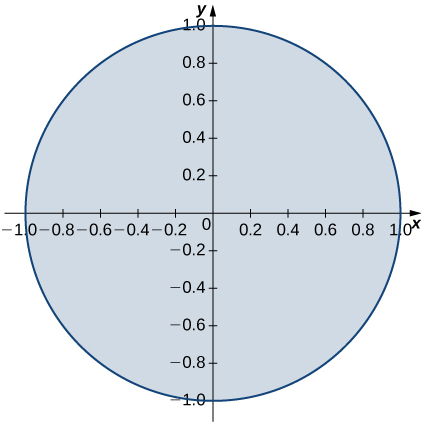
9. R is the region enclosed by the ellipse x2+4y2=1; ρ(x,y)=1.
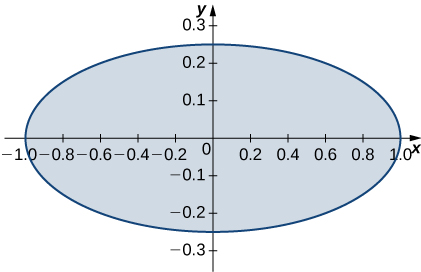
- Answer
- π2
10. R={(x,y)|9x2+y2≤1, x≥0, y≥0}; ρ(x,y)=√9x2+y2.
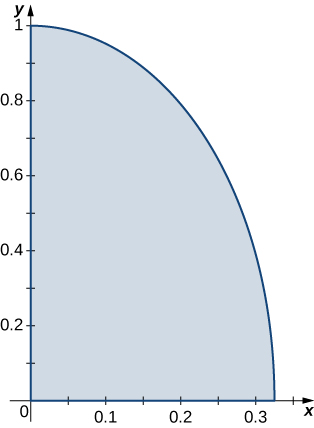
11. R is the region bounded by y=x, y=−x, y=x+2, y=−x+2; ρ(x,y)=1.
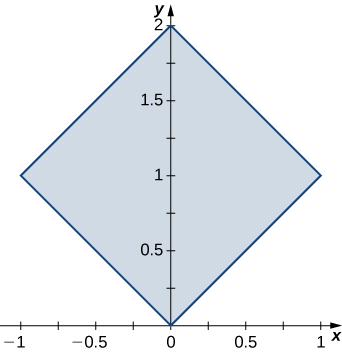
- Answer
- 2
12. R is the region bounded by y=1x, y=2x, y=1, and y=2; ρ(x,y)=4(x+y).
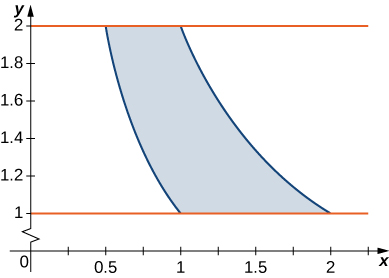
In exercises 13 - 24, consider a lamina occupying the region R and having the density function ρ given in the preceding group of exercises. Use a computer algebra system (CAS) to answer the following questions.
a. Find the moments Mx and My about the x-axis and y-axis, respectively.
b. Calculate and plot the center of mass of the lamina.
c. [T] Use a CAS to locate the center of mass on the graph of R.
13. [T] R is the triangular region with vertices (0,0), (0,3), and (6,0); ρ(x,y)=xy.
- Answer
-
a. Mx=815, My=1625;
b. ˉx=125, ˉy=65;
c.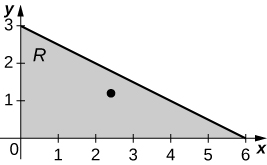
14. [T] R is the triangular region with vertices (0,0), (1,1), and (0,5); ρ(x,y)=x+y.
15. [T] R is the rectangular region with vertices (0,0), (0,3), (6,3), and (6,0); ρ(x,y)=√xy.
- Answer
-
a. Mx=216√25, My=432√25;
b. ˉx=185, ˉy=95;
c.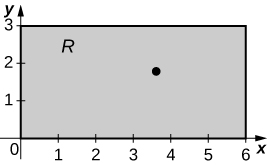
16. [T] R is the rectangular region with vertices (0,1), (0,3), (3,3), and (3,1); ρ(x,y)=x2y.
17. [T] R is the trapezoidal region determined by the lines y=−14x+52, y=0, y=2, and x=0; ρ(x,y)=3xy.
- Answer
-
a. Mx=3685, My=15525;
b. ˉx=9295, ˉy=38895;
c.
18. [T] R is the trapezoidal region determined by the lines y=0, y=1, y=x, and y=−x+3; ρ(x,y)=2x+y.
19. [T] R is the disk of radius 2 centered at (1,2); ρ(x,y)=x2+y2−2x−4y+5.
- Answer
-
a. Mx=16π, My=8π;
b. ˉx=1, ˉy=2;
c.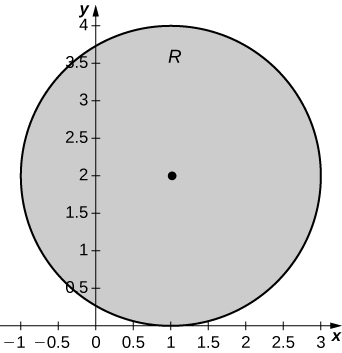
20. [T] R is the unit disk; ρ(x,y)=3x4+6x2y2+3y4.
21. [T] R is the region enclosed by the ellipse x2+4y2=1; ρ(x,y)=1.
- Answer
-
a. Mx=0, My=0);
b. ˉx=0, ˉy=0;
c.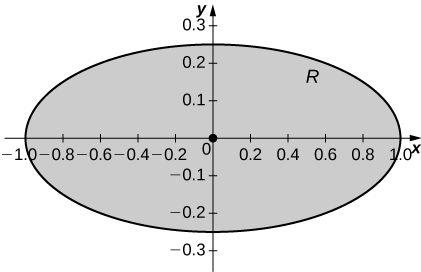
22. [T] R={(x,y)|9x2+y2≤1, x≥0, y≥0}; ρ(x,y)=√9x2+y2.
23. [T] R is the region bounded by y=x, y=−x, y=x+2, and y=−x+2; ρ(x,y)=1.
- Answer
-
a. Mx=2, My=0);
b. ˉx=0, ˉy=1;
c.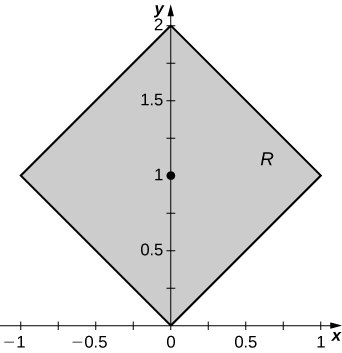
24. [T] R is the region bounded by y=1x, y=2x, y=1, and y=2; ρ(x,y)=4(x+y).
In exercises 25 - 36, consider a lamina occupying the region R and having the density function ρ given in the first two groups of Exercises.
a. Find the moments of inertia Ix, Iy and I0 about the x-axis, y-axis, and origin, respectively.
b. Find the radii of gyration with respect to the x-axis, y-axis, and origin, respectively.
25. R is the triangular region with vertices (0,0), (0,3), and (6,0); ρ(x,y)=xy.
- Answer
- a. Ix=24310, Iy=4865, and I0=2432;
b. Rx=3√55, Ry=6√55, and R0=3
26. R is the triangular region with vertices (0,0), (1,1), and (0,5); ρ(x,y)=x+y.
27. R is the rectangular region with vertices (0,0), (0,3), (6,3), and (6,0); ρ(x,y)=√xy.
- Answer
- a. Ix=2592√27, Iy=648√27, and I0=3240√27;
b. Rx=6√217, Ry=3√217, and R0=3√1067
28. R is the rectangular region with vertices (0,1), (0,3), (3,3), and (3,1); ρ(x,y)=x2y.
29. R is the trapezoidal region determined by the lines y=−14x+52, y=0, y=2, and x = 0; \space \rho (x,y) = 3xy\).
- Answer
- a. Ix=88, Iy=1560, and I0=1648;
b. Rx=√41819, Ry=√741010, and R0=2√195719
30. R is the trapezoidal region determined by the lines y=0, y=1, y=x, and y = -x + 3; \space \rho (x,y) = 2x + y\).
31. R is the disk of radius 2 centered at (1,2); ρ(x,y)=x2+y2−2x−4y+5.
- Answer
- a. Ix=128π3, Iy=56π3, and I0=184π3;
b. Rx=4√33, Ry=√212, and R0=√693
32. R is the unit disk; ρ(x,y)=3x4+6x2y2+3y4.
33. R is the region enclosed by the ellipse x2+4y2=1; ρ(x,y)=1.
- Answer
- a. Ix=π32, Iy=π8, and I0=5π32;
b. Rx=14, Ry=12, and R0=√54
34. R={(x,y)|9x2+y2≤1, x≥0, y≥0}; ρ(x,y)=√9x2+y2.
35. R is the region bounded by y=x, y=−x, y=x+2, and y=−x+2; ρ(x,y)=1.
- Answer
- a. Ix=73, Iy=13, and I0=83;
b. Rx=√426, Ry=√66, and R0=2√33
36. R is the region bounded by y=1x, y=2x, y=1, and y=2; ρ(x,y)=4(x+y).
37. Let Q be the solid unit cube. Find the mass of the solid if its density ρ is equal to the square of the distance of an arbitrary point of Q to the xy-plane.
- Answer
- m=13
38. Let Q be the solid unit hemisphere. Find the mass of the solid if its density ρ is proportional to the distance of an arbitrary point of Q to the origin.
39. The solid Q of constant density 1 is situated inside the sphere x2+y2+z2=16 and outside the sphere x2+y2+z2=1. Show that the center of mass of the solid is not located within the solid.
40. Find the mass of the solid Q={(x,y,z)|1≤x2+z2≤25, y≤1−x2−z2} whose density is ρ(x,y,z)=k, where k>0.
41. [T] The solid Q={(x,y,z)|x2+y2≤9, 0≤z≤1, x≥0, y≥0} has density equal to the distance to the xy-plane. Use a CAS to answer the following questions.
a. Find the mass of Q.
b. Find the moments Mxy, Mxz and Myz about the xy-plane, xz-plane, and yz-plane, respectively.
c. Find the center of mass of Q.
d. Graph Q and locate its center of mass.
- Answer
-
a. m=9π4;
b. Mxy=3π2, Mxz=818, Myz=818;
c. ˉx=92π, ˉy=92π, ˉz=23;
d.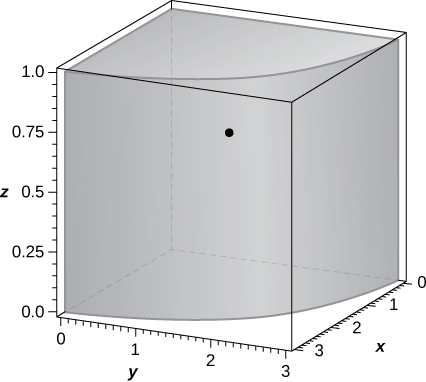
42. Consider the solid Q={(x,y,z)|0≤x≤1, 0≤y≤2, 0≤z≤3} with the density function ρ(x,y,z)=x+y+1.
a. Find the mass of Q.
b. Find the moments Mxy, Mxz and Myz about the xy-plane, xz-plane, and yz-plane, respectively.
c. Find the center of mass of Q.
43. [T] The solid Q has the mass given by the triple integral ∫1−1∫π/40∫10r2dr dθ dz.
Use a CAS to answer the following questions.
- Show that the center of mass of Q is located in the xy-plane.
- Graph Q and locate its center of mass.
- Answer
-
ˉx=3√22π, ˉy=3(2−√2)2π, ˉz=0; 2. the solid Q and its center of mass are shown in the following figure.
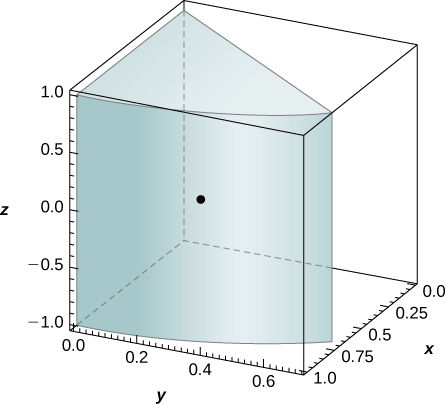
44. The solid Q is bounded by the planes x+4y+z=8, x=0, y=0, and z=0. Its density at any point is equal to the distance to the xz-plane. Find the moments of inertia of the solid about the xz-plane.
45. The solid Q is bounded by the planes x+y+z=3, x=0, y=0, and z=0. Its density is ρ(x,y,z)=x+ay, where a>0. Show that the center of mass of the solid is located in the plane z=35 for any value of a.
46. Let Q be the solid situated outside the sphere x2+y2+z2=z and inside the upper hemisphere x2+y2+z2=R2, where R>1. If the density of the solid is ρ(x,y,z)=1√x2+y2+z2, find R such that the mass of the solid is 7π2.
47. The mass of a solid Q is given by ∫20∫√4−x20∫√16−x2−y2√x2+y2(x2+y2+z2)ndz dy dx, where n is an integer. Determine n such the mass of the solid is (2−√2)π.
- Answer
- n=−2
48. Let Q be the solid bounded above the cone x2+y2=z2 and below the sphere x2+y2+z2−4z=0. Its density is a constant k>0. Find k such that the center of mass of the solid is situated 7 units from the origin.
49. The solid Q={(x,y,z)|0≤x2+y2≤16, x≥0, y≥0, 0≤z≤x} has the density ρ(x,y,z)=k. Show that the moment Mxy about the xy-plane is half of the moment Myz about the yz-plane.
50. The solid Q is bounded by the cylinder x2+y2=a2, the paraboloid b2−z=x2+y2, and the xy-plane, where 0<a<b. Find the mass of the solid if its density is given by ρ(x,y,z)=√x2+y2.
51. Let Q be a solid of constant density k, where k>0, that is located in the first octant, inside the circular cone x2+y2=9(z−1)2, and above the plane z=0. Show that the moment Mxy about the xy-plane is the same as the moment Myz about the xz-plane.
52. The solid Q has the mass given by the triple integral ∫10∫π/20∫r30(r4+r) dz dθ dr.
a. Find the density of the solid in rectangular coordinates.
b. Find the moment Mxy about the xy-plane.
53. The solid Q has the moment of inertia Ix about the yz-plane given by the triple integral ∫20∫√4−y2−√4−y2∫√x2+y212(x2+y2)(y2+z2)(x2+y2)dz dx dy.
a. Find the density of Q.
b. Find the moment of inertia Iz about the xy-plane.
- Answer
- a. ρ(x,y,z)=x2+y2;
b. 16π7
54. The solid Q has the mass given by the triple integral ∫π/40∫2 sec θ0∫10(r3cosθsinθ+2r)dz dr dθ.
a. Find the density of the solid in rectangular coordinates.
b. Find the moment Mxz about the xz-plane.
55. Let Q be the solid bounded by the xy-plane, the cylinder x2+y2=a2, and the plane z=1, where a>1 is a real number. Find the moment Mxy of the solid about the xy-plane if its density given in cylindrical coordinates is ρ(x,y,z)=d2fdr2(r), where f is a differentiable function with the first and second derivatives continuous and differentiable on (0,a).
- Answer
- Mxy=π(f(0)−f(a)+af′(a))
56. A solid Q has a volume given by ∬D∫badA dz, where D is the projection of the solid onto the xy-plane and a<b are real numbers, and its density does not depend on the variable z. Show that its center of mass lies in the plane z=a+b2.
57. Consider the solid enclosed by the cylinder x2+z2=a2 and the planes y=b and y=c, where a>0 and b<c are real numbers. The density of Q is given by ρ(x,y,z)=f′(y), where f is a differential function whose derivative is continuous on (b,c). Show that if f(b)=f(c), then the moment of inertia about the xz-plane of Q is null.
58. [T] The average density of a solid Q is defined as ρave=1V(Q)∭Qρ(x,y,z)dV=mV(Q), where V(Q) and m are the volume and the mass of Q, respectively. If the density of the unit ball centered at the origin is ρ(x,y,z)=e−x2−y2−z2, use a CAS to find its average density. Round your answer to three decimal places.
59. Show that the moments of inertia Ix, Iy, and Iz about the yz-plane, xz-plane, and xy-plane, respectively, of the unit ball centered at the origin whose density is ρ(x,y,z)=e−x2−y2−z2 are the same. Round your answer to two decimal places.
- Answer
- Ix=Iy=Iz≈0.84
Contributors
Gilbert Strang (MIT) and Edwin “Jed” Herman (Harvey Mudd) with many contributing authors. This content by OpenStax is licensed with a CC-BY-SA-NC 4.0 license. Download for free at http://cnx.org.


